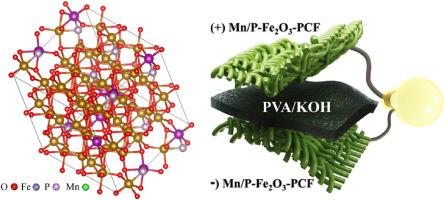Enhanced electrochemical performance of dendritic Fe2O3 nanowires on hollow carbon nanofibers with manganese and phosphorus co-doping for solid-state symmetric supercapacitors
IF 7.9
2区 工程技术
Q1 CHEMISTRY, PHYSICAL
引用次数: 0
Abstract
Maximizing the energy and power density of supercapacitors requires a sophisticated hierarchical three-dimensional structured active material allowing high accessibility to electrons and ions. The mass, charge, and mass balance between the anode and cathode are other hurdles in fabricating asymmetric supercapacitors due to the large specific capacitance difference. Herein, we report a symmetric supercapacitor based on hierarchical interconnected iron oxide on three-dimensional porous and hollow electrospun carbon nanofibers following in situ doping of Mn and P doping. X-ray absorption (XAS) studies revealed that the synergistic effect of Mn and P strengthens the electronic structure of Fe2O3. The introduction of Mn increases the electron density around the central metals, whereas P doping effectively strengthens chemical bonding to promote long-term chemical stability. As a result, Mn/P-Fe2O3-PCF exhibited an excellent areal specific capacitance of 2506 mF cm−2, superior rate performance, and outstanding stability. Moreover, the assembled Mn/P-Fe2O3-PCF solid-state symmetric supercapacitor device delivered a high areal energy density of 85.41 μW h cm−2 at a power density of 499.96 mWcm−2. The delicate design of the binder-free nanostructures in this work suggests a new approach to inhibit growth and structure modulation for high-performance energy storage devices.

锰磷共掺杂在空心碳纳米纤维上增强树枝状Fe2O3纳米线用于固态对称超级电容器的电化学性能
最大化超级电容器的能量和功率密度需要一种复杂的分层三维结构活性材料,允许电子和离子的高可及性。阳极和阴极之间的质量、电荷和质量平衡是制造非对称超级电容器的另一个障碍,因为它们的比电容差异很大。在此,我们报道了一种基于分层互连氧化铁的对称超级电容器,该电容器基于三维多孔和空心静电纺碳纳米纤维,并在原位掺杂Mn和P。x射线吸收(XAS)研究表明,Mn和P的协同作用增强了Fe2O3的电子结构。Mn的引入增加了中心金属周围的电子密度,而P的掺杂有效地增强了化学键,促进了长期的化学稳定性。结果表明,Mn/P-Fe2O3-PCF具有2506 mF cm−2的优异面比电容、优越的倍率性能和优异的稳定性。此外,组装的Mn/P-Fe2O3-PCF固态对称超级电容器器件在499.96 mWcm - 2的功率密度下,具有85.41 μW h cm - 2的高面能密度。在这项工作中,无粘结剂纳米结构的精致设计为抑制高性能储能器件的生长和结构调制提供了一种新的方法。
本文章由计算机程序翻译,如有差异,请以英文原文为准。
求助全文
约1分钟内获得全文
求助全文
来源期刊

Journal of Power Sources
工程技术-电化学
CiteScore
16.40
自引率
6.50%
发文量
1249
审稿时长
36 days
期刊介绍:
The Journal of Power Sources is a publication catering to researchers and technologists interested in various aspects of the science, technology, and applications of electrochemical power sources. It covers original research and reviews on primary and secondary batteries, fuel cells, supercapacitors, and photo-electrochemical cells.
Topics considered include the research, development and applications of nanomaterials and novel componentry for these devices. Examples of applications of these electrochemical power sources include:
• Portable electronics
• Electric and Hybrid Electric Vehicles
• Uninterruptible Power Supply (UPS) systems
• Storage of renewable energy
• Satellites and deep space probes
• Boats and ships, drones and aircrafts
• Wearable energy storage systems
 求助内容:
求助内容: 应助结果提醒方式:
应助结果提醒方式:


